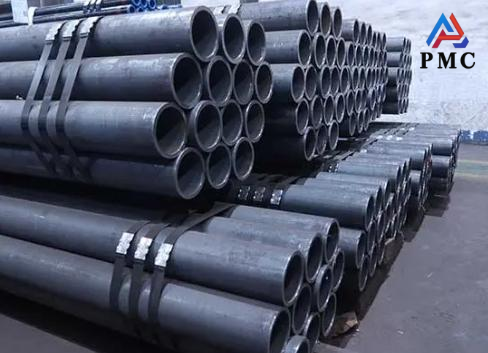
Seamless Steel Pipe for Tunnel
Tunnel seamless steel pipe refers to a type of seamless steel pipe used in tunnel engineering for support, drainage, ventilation, pipeline laying, grouting, and advance reinforcement. These pipes are engineered to meet the demanding requirements of tunnel construction, offering high strength, pressure resistance, and long-term durability in complex underground environments.
Tunnel seamless steel pipe refers to a seamless steel pipe used for support, drainage, ventilation, pipeline laying, grouting and advance support in tunnel engineering. This type of steel pipe needs to have special mechanical properties and durability to cope with the complex environment in tunnel construction and operation. Common specifications such as ASTM A106 pipe and ASTM A53 pipe are often selected to ensure performance under high pressure and temperature conditions.
In addition, choosing the proper seamless pipe size is essential to meet the specific demands of different tunnel applications. The following carefully summarizes the characteristics, uses and precautions of tunnel seamless steel pipe.
Characteristics of seamless steel pipes for tunnels
High load-bearing capacity: When used as supporting structures or advance supports, tunnel steel pipes need to withstand the huge pressure of the surrounding rock, ground stress, and construction loads. Therefore, the steel pipes must have high strength and high rigidity to prevent deformation or collapse.
Good machinability: In tunnel engineering, steel pipes often need to be cut, welded, bent, and processed to adapt to the complex geometric shape of the tunnel. The steel pipe material should have good weldability and plasticity to facilitate on-site construction.
Corrosion resistance: The internal environment of a tunnel is usually humid and may contain corrosive gases or groundwater. Steel pipes need to have a certain degree of corrosion resistance to ensure the safety of the structure in long-term use. This is usually achieved through material selection (such as stainless steel) or external anti-corrosion treatment (such as hot-dip galvanizing, epoxy resin coating).
Diversified specifications: Tunnel projects have different requirements for the diameter and wall thickness of steel pipes depending on the specific purpose and geological conditions. From small grouting pipes to large support pipes, the specifications range is very wide.
Common uses of seamless steel pipes for tunnels
1. Advanced support pipe
Purpose: Before tunnel excavation, a pre-reinforced "arch" structure is formed by drilling and inserting steel pipes, and then grouting. This can effectively stabilize the tunnel face, reduce the loosening and deformation of the surrounding rock, and prevent landslides. It is an important safety measure for tunnel excavation.
Features: Usually small diameter (such as 30-50mm), thin-walled seamless steel pipes are used, and the material is required to have certain strength and weldability.
2. Pipe shed support
Application: In weak surrounding rock or fractured zones, large diameter (e.g. 108-159mm) and thick-walled steel pipes are used as pipe sheds to form a protective "scaffolding" on the top and sides of the tunnel, which is then grouting-consolidated to provide strong initial support.
Features: The steel pipe is required to have high strength and bearing capacity to withstand the pressure of the formation.

3. Grouting pipe
Application: Used to inject cement slurry, chemical slurry, etc. into surrounding rocks or strata to reinforce strata, fill cavities or waterproof.
Features: Usually a small diameter steel pipe, the material is required to be straight and the surface is smooth to ensure the smooth transportation of slurry.
4. Drain pipe
Application: Laid inside tunnels to collect and drain seepage water, preventing it from corroding equipment or disrupting operations.
Features: Relatively low strength requirements are required, but corrosion resistance is essential. Ordinary carbon steel pipes or PVC pipes are typically used.
5. Ventilation ducts and pipeline casings
Applications: Used in ventilation systems or as protective casing for power cables, optical cables, and other pipelines.
Features: Moderate strength requirements are required, but good workability and corrosion resistance are essential.
Material selection and construction considerations
Geological conditions are the primary consideration: when selecting steel pipes for tunnels, factors such as the stability of the surrounding rock, groundwater conditions, and the magnitude of ground stress must be considered based on a detailed geological survey report.
Strictly adhere to design specifications: All tunnel projects must comply with national or industry-related design and construction specifications. The material, specifications, and installation methods of the steel pipes must strictly match the design drawings.
Ensure connection quality: Whether it is welding or other connection methods, the strength and sealing of the joints must be ensured. Welding must be completed by qualified welders and necessary quality inspections must be carried out.
Anti-corrosion protection: For steel pipes exposed to humid environments for a long time, effective anti-corrosion treatment must be carried out to extend their service life and ensure structural safety.
Read more: Advantages of Seamless Pipes in Pipeline Transportation


